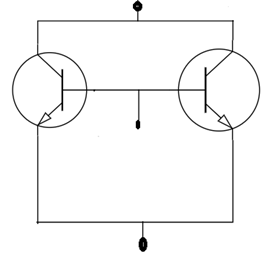This set of Electronic Devices and Circuits Multiple Choice Questions & Answers (MCQs) focuses on “Thermal Runaway”.
1. Thermal runaway is_________
a) an uncontrolled positive feedback
b) a controlled positive feedback
c) an uncontrolled negative feedback
d) a controlled negative feedback
View Answer
Explanation: Thermal runaway is a self destruction process in which an increase in temperature creates such a condition which in turn increases the temperature again. This uncontrolled rise in temperature causes the component to get damaged.
2. The thermal runway is avoided in a self bias because_________
a) of its independence on β
b) of the positive feedback produced by the emitter resistor
c) of the negative feedback produced by the emitter resistor
d) of its dependence on β
View Answer
Explanation: The self destruction of a transistor due to increase temperature is called thermal run away. It is avoided by the negative feedback produced by the emitter resistor in a self bias. The IC which is responsible for the damage is reduced by decreased output signal.
3. When the temperature is increased, what happens to the collector current after a feedback is given?
a) it remains same
b) it increases
c) it cannot be predicted
d) it decreases
View Answer
Explanation: Before the feedback is applied, when the temperature is increased, the reverse saturation increases. The collector current also increases. When the feedback is applied, the drop across the emitter resistor increases with decreasing collector current and the thermal runway too.
4. The thermal runway is avoided in a collector to base bias because_________
a) of its independence on β
b) of the positive feedback produced by the base resistor
c) of the negative feedback produced by the base resistor
d) of its dependence on β
View Answer
Explanation: The self destruction of a transistor due to increase temperature is called thermal run away. It is avoided by the negative feedback produced by the base resistor in a collector to base bias. The IC which is responsible for the damage is reduced by decreased output signal.
5. When the temperature is increased, what happens to the collector current after a feedback is given?
a) it remains same
b) it increases
c) it cannot be predicted
d) it decreases
View Answer
Explanation: Before the feedback is applied, when the temperature is increased, the reverse saturation increases. The collector current also increases. When the feedback is applied, the base current increases with decreasing collector current and the thermal runway too.
6. Discrete transistors T1 and T2 having maximum collector current rating of 0.75A are connected in parallel as shown in the figure. This combination is treated as a single transistor to carry a single current of 1A, when biased with a self bias circuit. When the circuit is switched ON, T1 had draws 0.55A and T2 draws 0.45A. If the supply is kept ON continuously, it is very likely that_________

a) both T1 and T2 get damaged
b) both T1 and T2 will be safe
c) only T1 gets damaged
d) only T2 gets damaged
View Answer
Explanation: The T1 transistor is having more power dissipation as it is drawing 0.55A. When power dissipation increases, the temperature increases and this leads to the ultimate further increase in the current drawn by T1. The current drawn by T2 will be reduced as the sum of currents drawn by T1 and T2 should be constant.
7. When the collector current is increased in a transistor_________
a) the reverse current is increased
b) the temperature is increased
c) collisions of electrons decrease
d) the emitter does not emit electrons
View Answer
Explanation: As the collector current is increased, the emitter releases more number of electrons. This causes more collisions of electrons at collector. This happens in a cycle and produces such a condition in which temperature is further more increased.
8. Which of the following are true?
a) TJ – TA = θPd
b) TJ – TA = θ/Pd
c) TJ – TA = θ+Pd
d) TJ – TA = θ-Pd
View Answer
Explanation: The TJ is called as junction temperature which varies and TA is called as the ambient temperature which is fixed. The difference between these temperatures is directly proportional to the power dissipation. Here, θ is called as thermal resistance which is proportionality constant.
9. When the power dissipation increases in a transistor, the thermal resistance_________
a) increases
b) cannot be predicted
c) decreases
d) remains same
View Answer
Explanation: The power dissipation is directly proportional to thermal resistance. We have, TJ – TA = θPd in which we can observe θ ∝ 1/Pd. So, a device with low power dissipation has high thermal resistance.
10. Which of the following biasing techniques are prone to thermal runaway?
a) self bias
b) collector to base bias
c) fixed bias
d) the biasing technique is identified by temperature effect
View Answer
Explanation: The collector current of a fixed bias transistor is IC= β(VCC-VBE)/RB. When the temperature is increased, the reverse saturation increases. The collector current also increases. This in turn increases the current again which leads to damage of transistor.
Sanfoundry Global Education & Learning Series – Electronic Devices and Circuits.
To practice all areas of Electronic Devices and Circuits, here is complete set of 1000+ Multiple Choice Questions and Answers.
If you find a mistake in question / option / answer, kindly take a screenshot and email to [email protected]
